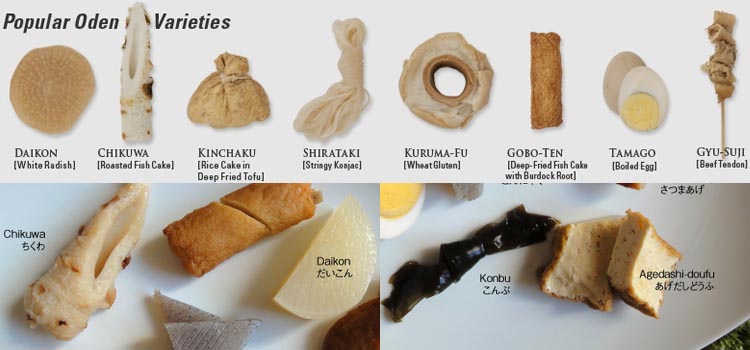In today's article we are going to talk about Oden (おでん), a dish that is very popular in winter but can be found at any time in the convenience stores, markets, restaurants and street stalls. Oden is a dish consisting of various vegetables, tofu, eggs and others cooked in soy sauce and dashi sauce (fish sauce).
The dish may not appeal to Westerners due to its appearance and food present in it. However, its flavor is interesting and helps to warm up in the cold of winter. Several different ingredients go into the Oden recipe, it all depends on the region or province. The ingredients are usually dipped in the sauce and cooked until very soft, in konbini they are all the time dipped and hot.
Índice de Conteúdo
Oden's Ingredients
It is believed that there are over 60 varieties of foods and ingredients that are cooked in the dashi sauce that make up the Oden. In markets you can find ingredients ready to cook and make your own at home. Below we will see a list of the most popular ones:
- Yude tamago - ゆで卵 - Boiled eggs;
- Daikon - 大根 - Turnip;
- Konnyaku – Food produced from the konjac potato;
- Shirataki - 白滝 - Noodles made from konnyaku potato;
- Atsuage - 厚揚げ - Large pieces of fried tofu;
- Mochiiri Kinchaku – 餅入り巾着 – Made from fried tofu and stuffed with mochi ;
- Ganmodoki – Disc-shaped dumpling made from fried tofu and vegetables;
- Satsuma-age – さつま揚げ – Fried dumplings made with cod or other fish, vegetables and shredded carrots;
- Rooru kyabetsu – Cabbage bundle stuffed with ground chicken or pork;
- Gyuu suji - 牛すじ - Ox tendon, reminds a little mocotô;
- Chikuwabu – Dough made from fish, flour, water and salt;
- Yaki chikuwa – 焼ちくわ – Similar to Chikuwabu, but lightly fried before being placed in the oden;
- Tsukune - Chicken meatball on skewers;
- Ikamaki - Made from Squid;
- Konbu - Dried seaweed;
- Carrots, mushrooms, cabbage, octopus, etc;
Side sauces - In places like convenience stores, you can pick up a sauce to go with Oden, we have the karashi similar to mustard but spicier. Misotare a strong flavored soy paste sauce and the yuzugosho which is slightly sour sour and spicy.
Oden trivia
Nishime - Cooked vegetables – Something similar to Oden is Nishime which consists of vegetables cut and cooked in sauces. The differences are that nishime has little broth and is more salty. In addition, the ingredients of nishime are all cut while Oden is usually large and whole.
The Oden ends up being called by other names in some regions. In Nagoya it may be known as Kantou-ni, in the Kansai area it is known as Kanto-daki. In some regions the broth may be lighter or darker. The oden has already been exported to some countries such as China, Korea and Taiwan and has its differences and variations.
Have you ever had the experience of eating this dish? What do you think? Leave your comments below and share with friends.






